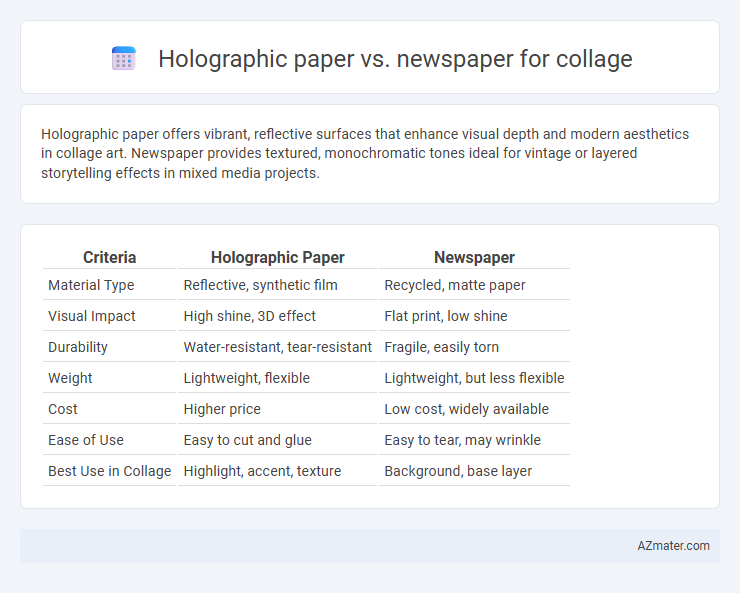Holographic paper offers vibrant, reflective surfaces that enhance visual depth and modern aesthetics in collage art. Newspaper provides textured, monochromatic tones ideal for vintage or layered storytelling effects in mixed media projects.
Table of Comparison
| Criteria | Holographic Paper | Newspaper |
|---|---|---|
| Material Type | Reflective, synthetic film | Recycled, matte paper |
| Visual Impact | High shine, 3D effect | Flat print, low shine |
| Durability | Water-resistant, tear-resistant | Fragile, easily torn |
| Weight | Lightweight, flexible | Lightweight, but less flexible |
| Cost | Higher price | Low cost, widely available |
| Ease of Use | Easy to cut and glue | Easy to tear, may wrinkle |
| Best Use in Collage | Highlight, accent, texture | Background, base layer |
Introduction to Collage Materials
Holographic paper provides a vibrant, reflective surface ideal for adding dynamic visual effects and depth to collages, contrasting with the matte, textural qualities of traditional newspaper. Newspaper offers rich text and grayscale imagery that contributes an authentic, vintage or rustic aesthetic. Selecting between holographic paper and newspaper depends on the desired visual impact and thematic emphasis in collage art.
Understanding Holographic Paper
Holographic paper features a reflective, multi-dimensional surface created by microstructures that diffract light, offering vibrant colors and a dynamic visual effect ideal for collage art seeking depth and movement. Unlike traditional newspaper, which is matte and absorbent with printed text and images, holographic paper provides a durable, eye-catching medium that enhances light interaction and stands out in mixed-media projects. Understanding the texture, light response, and adhesive compatibility of holographic paper is crucial for artists aiming to achieve striking contrasts and layered compositions in collages.
Overview of Newspaper in Collage Art
Newspaper is a versatile and accessible material widely used in collage art for its texture and printed imagery that offer rich narrative potential. The monochromatic text and images provide contrast and depth, allowing artists to create dynamic compositions with historical or contemporary relevance. Its lightweight nature and ease of manipulation make newspaper an ideal choice for layering and mixed media techniques in collage creation.
Visual Impact: Holographic vs Newspaper
Holographic paper offers vibrant, reflective colors that create a dynamic, eye-catching visual impact in collage art, enhancing depth and movement with its shimmering surface. Newspaper provides a textured, monochromatic aesthetic that lends a vintage or gritty feel, emphasizing contrast and layered storytelling through text and images. Choosing between holographic paper and newspaper depends on the desired visual outcome: holographic for bright, modern effects and newspaper for classic, narrative-rich compositions.
Texture and Material Qualities
Holographic paper features a smooth, reflective surface with a prismatic sheen, offering dynamic light interaction that enhances collage layers with vibrant, eye-catching effects. Newspaper provides a matte, porous texture, enabling easy ink absorption and flexible manipulation, which adds a vintage or raw aesthetic to collage art. The choice between holographic paper and newspaper depends on desired tactile contrast and visual depth, as holographic paper emphasizes shimmer and modernity while newspaper contributes warmth and textural complexity.
Color and Reflectivity Differences
Holographic paper offers vibrant, iridescent colors that shift and change with light, creating dynamic visual effects ideal for eye-catching collages. Newspaper provides muted, matte tones with low reflectivity, lending a textured, vintage aesthetic but lacking the luminosity of holographic materials. The contrast in reflectivity and color saturation makes holographic paper better suited for modern, bold designs, while newspaper excels in creating subtle, layered compositions.
Accessibility and Cost Comparison
Holographic paper offers vibrant, reflective surfaces ideal for eye-catching collage elements but tends to be more expensive and less widely available than traditional newspaper. Newspapers provide an affordable, easily accessible option with diverse textures and print patterns, enhancing creative flexibility without significant cost. Choosing between the two depends largely on budget constraints and the desired visual impact in the collage project.
Versatility in Artistic Techniques
Holographic paper offers unmatched versatility in artistic techniques, allowing artists to play with light, reflections, and color shifts that enhance collage depth and dynamism. Newspaper provides a textured base rich in typographic and photographic elements, ideal for layering, textural contrast, and narrative storytelling within collage art. Combining holographic paper with newspaper in collage projects unlocks innovative visual effects and mixed-media possibilities.
Sustainability and Environmental Concerns
Holographic paper often contains non-recyclable materials like metallic films and plastics, making it less eco-friendly compared to traditional newspaper, which is biodegradable and widely recyclable. Newspapers, made from renewable resources and supporting sustainable forestry practices, provide a more environmentally responsible choice for collage projects. Choosing newspaper reduces landfill waste and lowers carbon footprint, aligning with sustainable art techniques.
Choosing the Right Material for Your Collage
Holographic paper offers vibrant colors and reflective surfaces that create dynamic, eye-catching effects, making it ideal for collages requiring a futuristic or high-impact aesthetic. Newspaper provides textured, monochromatic tones with printed text and images, perfect for vintage or thematic collages emphasizing storytelling and contrast. Selecting the right material depends on the desired visual impact, with holographic paper enhancing brightness and depth, while newspaper adds a tactile and narrative element.

Infographic: Holographic paper vs Newspaper for Collage
 azmater.com
azmater.com